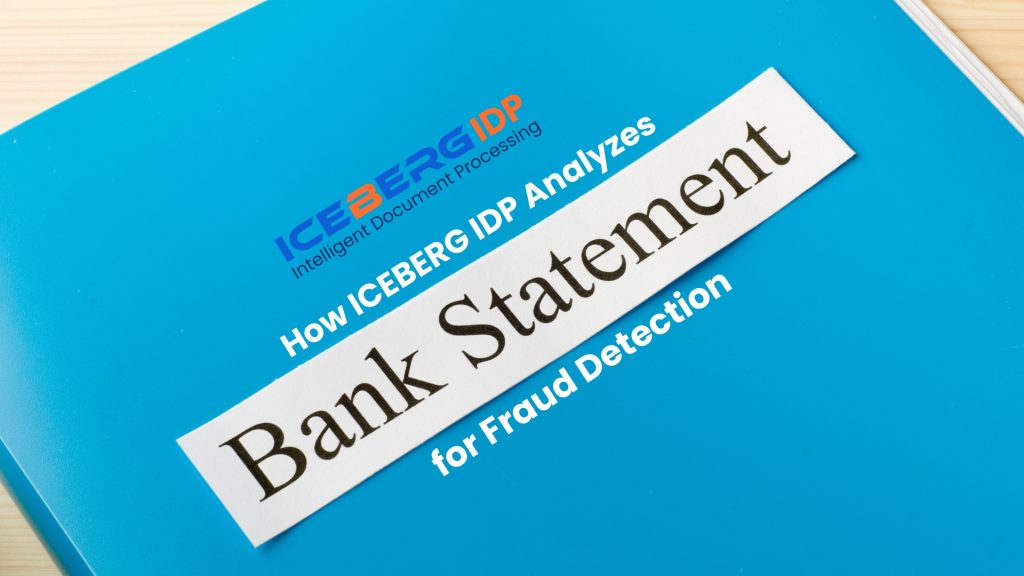Financial fraud, especially in the form of falsified bank statements, poses a significant threat to the financial industry. Reports suggest that over 85% of financial fraud cases involve altered or tampered documents, leading to substantial losses and reputational damage. In response, ICEBERG Intelligent Document Processing (IDP) offers a robust solution to streamline fraud detection through automation, artificial intelligence, and advanced validation techniques.

The Three-Step Fraud Detection Process
1. Data Extraction: Turning Raw Documents into Actionable Data
Fraud detection begins with accurate data extraction. ICEBERG IDP employs Optical Character Recognition (OCR) enhanced with Artificial Intelligence (AI) to process diverse bank statement formats, including scanned documents, PDFs, and digital copies.
- Accuracy & Efficiency: Unlike traditional OCR, ICEBERG’s AI-enhanced OCR can identify and correct misreads due to poor document quality or unconventional formatting.
- Structured Outputs: The extracted data is transformed into structured formats, enabling downstream analysis without manual intervention.
- Example Use Case: When processing a statement, the system automatically extracts line items, such as transaction amounts, dates, and references, into a digital ledger for seamless processing.
2. Anomaly Detection: Identifying Suspicious Patterns
Once the data is digitized, ICEBERG IDP applies machine learning models to detect anomalies within the transactions. This step is critical for identifying potential fraud patterns such as:
- Mismatched Balances: Flagging instances where reported balances do not align with the recorded transactions.
- Duplicate Transactions: Detecting repeated transactions that may indicate fraudulent attempts to inflate balances or obscure illicit transfers.
- Unusual Credits/Debits: Highlighting high-value transactions or those outside the customer’s typical spending behavior.
The system’s machine learning capabilities continuously improve with each new data set, ensuring more refined and reliable fraud detection over time.
3. Validation Check: Ensuring Data Authenticity
In the final step, ICEBERG IDP validates the extracted data against multiple sources:
- External Databases: Cross-referencing transaction data with third-party sources, such as credit bureaus, to verify accuracy.
- Internal Records: Comparing details like account numbers, customer IDs, and historical transaction patterns within the institution’s own systems.
- Fraud Indicators: Employing advanced algorithms to identify document tampering, such as altered fonts, spacing irregularities, or inconsistent metadata.
By combining cross-referencing with sophisticated algorithms, ICEBERG ensures that only verified and reliable information moves forward in the decision-making process.
Real-Time Processing for Proactive Fraud Mitigation
One of the standout features of ICEBERG IDP is its real-time processing capability, which significantly reduces the time required to identify and respond to fraudulent activities. Financial institutions can process large volumes of documents simultaneously, ensuring that fraud is caught before it escalates.
- Speed: What traditionally took hours or even days is now completed in minutes.
- Scalability: Whether analyzing thousands of transactions for a retail bank or a handful for a private institution, ICEBERG scales effortlessly.
Beyond Fraud Detection: Added Benefits of ICEBERG IDP
While fraud detection is a primary focus, ICEBERG IDP offers additional benefits that enhance overall document processing workflows:
- Regulatory Compliance: The system aligns with global standards like AML (Anti-Money Laundering) and KYC (Know Your Customer) requirements.
- Cost Efficiency: Automating manual tasks reduces overhead and allows financial institutions to reallocate resources to higher-value activities.
- Customer Experience: Faster processing times translate into quicker responses for customer applications, improving satisfaction and trust.
A Case in Point: ICEBERG IDP in Action
Consider a mid-sized bank that implemented ICEBERG IDP to process loan applications. By automating the analysis of applicant bank statements, the bank reduced its fraud-related losses by 30% within six months and improved processing speeds by 50%, enabling faster loan disbursements.
Conclusion: Take Action Against Fraud
Fraudulent bank statements can cause irreparable damage to financial institutions, both financially and reputationally. ICEBERG IDP provides a sophisticated, end-to-end solution to tackle this challenge head-on. With its advanced capabilities in data extraction, anomaly detection, and validation, ICEBERG empowers organizations to detect fraud swiftly and accurately.
Interested in learning more? Contact us today for a live demo of how ICEBERG IDP can transform your fraud detection processes. Together, we can make banking safer and more secure for everyone.